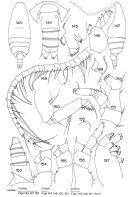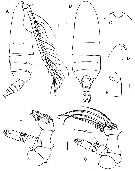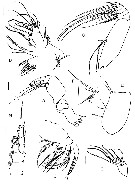|
|
 |
|
Calanoida ( Order ) |
|
|
|
Clausocalanoidea ( Superfamily ) |
|
|
|
Aetideidae ( Family ) |
|
|
|
Crassantenna ( Genus ) |
|
|
| |
Crassantenna comosa Bradford, 1969 (F) | |
| | | | | | | Ref.: | | | Bradford, 1969 b (p.493, Descr.F, figs.F); Bradford & Jillett, 1980 (p.29, figs.F, Rem., distribution chart); Markhaseva, 1996 (p.144, figs.F); Markhaseva & al., 2017 a (p.30, Redescr., Rem.) |  issued from : J.M. Bradford in N.Z. Jl Mar. Freshw. Res., 1969, 3 (4). [p.494, Figs 143-157]. Female (from N New Zealand: E of North Cape): 143, habitus (dorsal); 144, urosome (dorsal); 145, Mx1; 146, Md (mandibular palp); 147, habitus (lateral left side); 148, A1; 149, P1; 150, Mxp; 151, A2; 152, forehead (ventral view); 153, urosome (lateral left side); 154, P2; 155, P3; 156, P4; 157, Mx2. Nota: Cephalothorax more than 3 times longer than urosome. Rostrum present as a blunt plate. Posterior corners of last thoracic segment upturned backward. A1 reaches thoracic segment 5. A2: exopod almost as wide as endopod, exopod segment 1 without setae but with 2 lumps. Mx1: inner lobe 2 with 4 setae, inner lobe 3 with 2 setae.
|
 Crassantenna comosa Crassantenna comosa female: Exopodal segment 1 of A2 without setae. 3rd internal lobe of Mx1 with 2 setae.
|
 Issued from : E.L. Markhaseva, J.M. Bradford-Grieve & J. Renz in Arthropoda Selecta, 2017, 26 (1). [p.31, Fig.3]. Female (from 43°58.44'N, 157°1829'E at depths 5418-5419 m): A-B, habitus (lateral and dorsal, respectively); C-D, rostrum (dorsal and lateral view); E, genital double-somite (lateral view of ventral part); F, G, A2 different views. Scale bars: A-B = 0/5 mm, remaining figures 0.1 mm. Nota: - Prosome 3.6 times as long as urosome. - Cephalosome and pediger 1 partly fused, pedigers 4 and 5 fused dorsally (holotype), or partly fused (Kuril Trench). - Posterior corners of prosome slightly upturned dorsally, reaching posterior third of genital double-somite, shorter in holotype; posterior corners, in dorsal view, pressed close to genital double-somite, buy not as close and shorter in holotype. - Genital double-somite with spermathecae directed dorsoanteriorly, with oval distal part (fig.3E). - Rostrum as a blunt plate. - Caudal rami with 4 terminal, 1 ventral, and 1 dorsolateral setae (setae either broken or represented by a scar at the location of insertion. - A1 24-segmented, reaching pediger 5; setae mostly pseudoannulate and not plumose. - A2: coxa, basis and exopod slightly longer than endopod, setal formula 0, 0-1-1, 1,1,1,1,1,3; endopodal segments wide (wider than exopodal segments), segment 1 with 1 seta, segment 2 with 7 large outer terminal setae (6 in holotype), ande 8 inner subterminal setae (1 shorter, 2 inner setae very small).
|
 Issued from : E.L. Markhaseva, J.M. Bradford-Grieve & J. Renz in Arthropoda Selecta, 2017, 26 (1). [p.32, Fig.4]. Female: A, Md; B, Mx1; C, Mx2 without endopod; D, endopod of Mx2; E, Mxp syncoxa; F, Mxp coxa with sensory appendage marked by arrow; G, Mxp basis and endopod; H, P1. Scale bars = 0.1 mm. Nota: - Md: basis without seta; exopod 5-segmented, setal formula 1, 1, 1, 1, and 2 setae ; endopod segment 1 with 1 seta, segment 2 with 4 setae; gnathobase with 7 teeth, 3 small (in holotype these are sharp and narrow and almost as long as other teeth and, adjacent to the base of articulated seta, long setules situated at base of 3 sharp teeth). - Mx1: praecoxal arthrite (1st inner lobe) with 9 terminal, 3 (2 setae in holotype) posterior and 1 anterior setae; coxal endite (2nd inner lobe) with 4 setae, proximal basal endite (3rd inner lobe) with 3 (2 setae in holotype) and distal basal endite with 4 setae; endopod with 15 (4, 3 and 8 setae in holotype), segments 2 and 3 separate); exopod with 11 setae; coxal epipodite (opposte to the arthrite) with 7 long plus 2 short setae (damaged in holotype). - Mx2: all endites with 3 setal element; ptaecoxal to basal endites with yufts of spinules; endopod with 6 setae. - Mxp: praecoxal endites of syncoxa with 1, 2 and 3 setae (from proximal to distal, proximal seta broken in holotype), coxal endite of syncoxa with 3 setae and sensory appendage visible on one limb of Kutil specimen §fig.4F), althrough difficult to observe on the other mounted limb of Kuril specimen, basis with 3 medial setae; endopodal segment 1 without setae, not visible in Kuril specimen and holotype setal formula 0, 3, 3, 3, 3+1, and 4 setae. - P1: coxa without seta; basis with very small distolateral seta, medial distal seta curved; endopod 1-segmented, lateral lobe developed, spinulated; exopodal segments 1, 2 and 3 with 1 lateral spine each; lateral spine of exopodal segment 1 extending to base of 2nd exopodal segment lateral spine, extending to mid-length of exopodal segment 3, this lateral spine shorter than preceding spines. - P5 absent.
| | | | | Compl. Ref.: | | | Bradford-Grieve, 2004 (p.284) | | | | NZ: | 2 | | |
|
Distribution map of Crassantenna comosa by geographical zones
|
| | | | Loc: | | | SW Pacif. (NE New Zealand). NW Pacif. (Kuril Trench)
Type locality: 34°56' S, 175°23 'E. | | | | N: | 2 | | | | Lg.: | | | (230) F: 3,7; (1214) F: 3,70; {F: 3,70} | | | | Rem.: | hyperbenthic (± 1385 m); Abyssal in the Kuril Trench (5418 m) near the seabed.
After Markhaseva & al. (2017, p.33) this is the first record of the genus Crassantenna in the northern part of the Pacific Ocean. The specimen is identified as Cr. comosa. Certain features of the original description have been corrected after re-examination of the holotype. The minor differences from the holotype are assumed, to represent intraspecific variation. | | | Last update : 01/04/2018 | |
|
|
 Any use of this site for a publication will be mentioned with the following reference : Any use of this site for a publication will be mentioned with the following reference :
Razouls C., Desreumaux N., Kouwenberg J. and de Bovée F., 2005-2025. - Biodiversity of Marine Planktonic Copepods (morphology, geographical distribution and biological data). Sorbonne University, CNRS. Available at http://copepodes.obs-banyuls.fr/en [Accessed December 25, 2025] © copyright 2005-2025 Sorbonne University, CNRS
|
|
 |
 |






